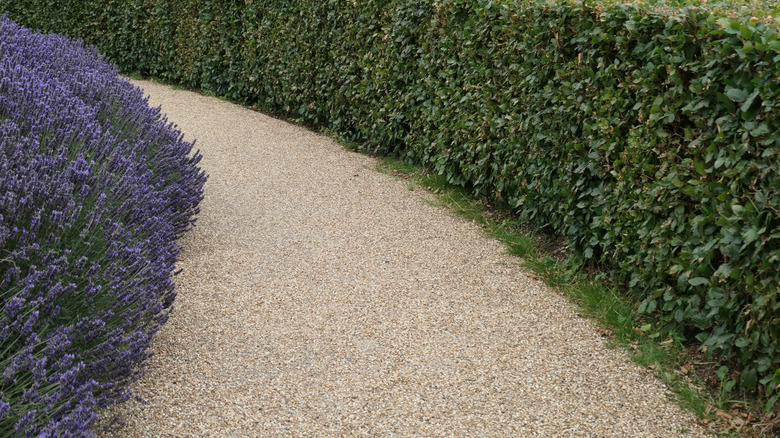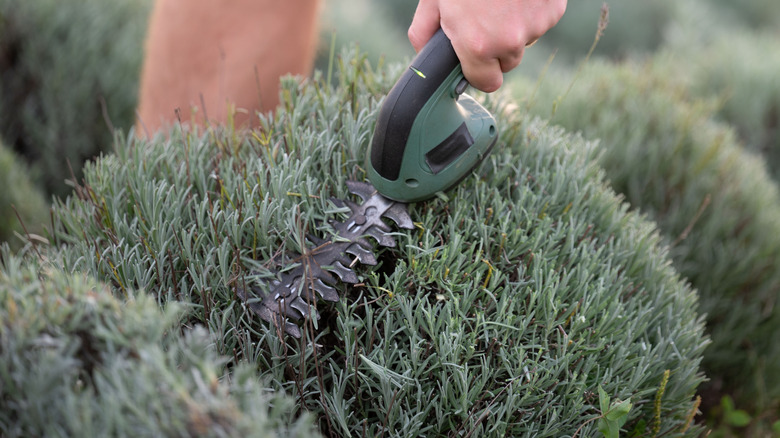Benefits Of Using Lavender As An Alternative Hedge Option
If you've ever visited or seen photos of those gorgeous lavender fields in France, Italy, the U.K., or even Australia, you'll notice that the plants are grown in straight or curved rows that look very much like hedgerows. That's because lavender's growth habit makes it quite easy to gently trim and shape into a stunning informal hedge, and it's been used for just this purpose around the world for centuries. While you might be familiar with the benefits of planting lavender in your edible garden, there are also many benefits of using lavender as an alternative hedge option. These include the outstanding visual impact provided by the gray-green foliage and purple blooms, the delightful aroma that envelops you as you walk up a lavender-lined path, and the ease of maintaining this outstanding display.
There are numerous varieties of lavender (Lavandula spp.) you can grow, depending on where you live. The most common are English lavender (Lavandula angustifolia), which grows in USDA hardiness zones 5 through 9, and French lavender (Lavandula stoechas), which only grows in zones 8 through 9. There are also many different hybrids and cultivars with even better growth habits, such as 'Hidcote', which has a compact mounded form to a height of 20 inches, and 'Nana Alba', which is a beautiful white flowering form that only grows to 12 inches in height. These more compact varieties are perfect as an alternative hedge along a path or walkway. There are also stunning lavender varieties you can grow together for even greater aesthetics.
Even more benefits to growing a lavender hedge
It probably doesn't surprise you that a lavender hedge can provide many different benefits to your yard. It looks far more attractive than other formal hedging options, especially when the plants are in full bloom. Those lovely scented flowers will add some glorious color to your garden and the mass planting creates this amazing wave effect, particularly if your paths are curved. On top of that, pollinators such as bees and butterflies will flock to your yard in droves as soon as the first flowers start to bask in the sunlight.
You'll also be pleased to know that lavender is deer-resistant. This makes it ideal as a border hedge around your flower and vegetable gardens to protect the more delicate plants that visiting deer might like to feast on, which is just another benefit of growing a lavender hedge in your yard. Of course, you'll have the added pleasure of being able to cut the blooms and use them to freshen up your home as you place armfuls of them into vases indoors. Plus, you'll find that they dry beautifully so you can use them in homemade potpourri or simply pop them into pretty bowls to place around your home. And, with all that abundance of lavender growing in your garden, you might be interested in some DIY lavender decorations you can make for the perfect cottage core home.
Everything you need to know about growing lavender as a hedge
Before you plant your lavender hedge so you can enjoy that distinctly herbal fragrance throughout your garden, make sure the growing conditions are right. Most importantly, this plant enjoys a full sun position and very well-drained soil. As long as you get these two things right, the plants should flourish in your garden. To grow a lavender hedge, space your young plants around 12 to 18 inches apart to get a nice display but still allow sufficient airflow. During their first year of growth, keep your plants sufficiently watered, but always ensure the soil doesn't stay wet. Lavender is totally drought-tolerant once established, which is another benefit of using it as a hedge alternative. If you're planning to mulch your plants, use something like pea gravel because this helps to keep the crown disease-resistant.
To keep your plants well-shaped, trim them back after they've bloomed for the first time, but avoid any pruning from late summer onwards. Once new growth appears in spring, you can do a heavy prune if needed. If you're growing one of the more compact hybrids, this shouldn't be necessary, and a light trim should be all that's needed. This is just one more benefit of using lavender as an alternative hedging option because its maintenance requirements are far less compared to other popular hedge species. Finally, your plants will appreciate regular fertilizer applications during the warm growing season, as this will promote better blooming.


